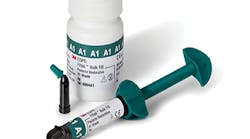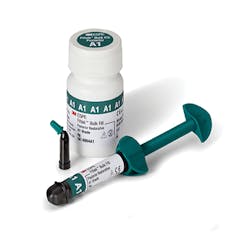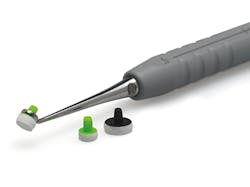Joshua Austin, DDS, FAGD
Filtek Bulk Fill posterior restorative
from 3M ESPE
Restorative material companies are usually pretty savvy. These companies understand that clinicians today want resin composite that can be filled in larger increments. Larger increments mean that less time is spent filling composites, which equals more overhead. We've seen SonicFill by Kerr, SureFil SDR by Dentsply Caulk, and other bulk fill materials hit the market to be adopted by clinicians immediately. There is no doubt that 3M ESPE saw this and knew it had to get into the bulk fill game ... and so it has.
Filtek Bulk Fill posterior restorative is here. I am a firm believer in using materials from companies that can provide support for their customers. As a multinational corporation with thousands of products, 3M ESPE is among the best when it comes to support. So if you've been waiting to jump into the bulk fill game, now is a good time.
Filtek Bulk Fill is recommended for class I and II posterior restorations. Class II restorations can be placed in 5 mm increments, while class I restorations have a 4 mm increment recommendation. The reason for the difference is that class II can be cured from different directions, allowing for a bit of a larger increment. The material handles similarly to Filtek Supreme. It has good body and can tolerate some packing force. It polishes well - similarly to Kerr SonicFill. Filtek Bulk Fill comes in five shades (A1, A2, A3, B1, C2), but I found it to be a bit translucent, which is probably by design to allow for a larger depth of cure. If the dentin substrate is dark from an old alloy, you will probably notice some of that through this material. Because of that, and as the product name indicates, usage is limited to posterior teeth.
Pros: Handles and polishes well; does not require any additional handpieces or hardware; includes 3M ESPE support, which is second to none
Cons: More translucent than other bulk fill materials (which is mitigated by limiting usage to posterior teeth)
Final thoughts: I enjoyed using Filtek Bulk Fill posterior restorative. I think it is an excellent material to use if you want to start using bulk fill composites but don't want the expense of adding a specialized handpiece. Filtek Bulk Fill is a solo home run!
OptraSculpt Pad
from Ivoclar Vivadent
Sculpting esthetic anterior composite restorations is a challenge for me. I was not an artist or a ceramist before going to dental school, nor did I build ice sculptures to pay my way through school. In terms of hand-eye coordination, I feel as though I am pretty average, so sculpting esthetic anterior restorations does not come easily for me. I need every advantage I can get.
When I saw a demo of the OptraSculpt Pad from Ivoclar Vivadent, I thought it was an excellent idea. The instrument has a traditional composite instrument on one side. The instrument handle has a reference scale on it for determining widths of anterior teeth, which is a nice touch. The other side has a detachable nonstick foam pad that enables the clinician to push and pat the composite into place. The pad side of the instrument has a nice angle that facilitates good access to anterior teeth, and the detachable pads are single-use disposables that come in large or small sizes.
In my hands, the OptraSculpt Pad has decreased restoration time and has given me better results. I find that it works best on class IV and V restorations. The push/pat motion this instrument allows seems to help reduce the chance of voids or porosity in the restoration. The pads are truly nonstick and work well to help you get the resin composite where you want it.
Pros: Reduces chair time for anterior composite restorations; facilitates placement and shaping of composite on class IV restorations; pads are truly nonstick; engineered for access to anterior teeth
Cons: Requires use of disposable single-use pad
Final thoughts: This instrument has become my go-to instrument for class IV and V anterior composite restorations. It makes me faster and gives me a result that requires less finishing. The OptraSculpt Pad is a home run for me!
ImplantConcierge.com
Guided implant surgery is quickly becoming the standard of care for many who do implants. Access to 3-D cone-beam computed tomography (CBCT) data has made guided surgery a much easier task for periodontists, oral maxillofacial surgeons, and general dentists. 3-D printing is quickly advancing to the point at which the pesky lab work involved with fabricating a surgical guide will be forgotten. As these technologies evolve and improve, it is increasingly difficult for dentists to be involved because of the cost of equipment and software licenses that are required. In these cases, having a facilitator for implant cases can be a huge benefit.
ImplantConcierge can be that facilitator. They have the ability to facilitate your implant cases using the latest in hardware and software at a minimum cost to you. The case all starts with a CBCT-based DICOM file, which can come from either your machine or a machine at an imaging center. Once uploaded, the software walks you through exactly what is needed to make your case a slam-dunk. After uploading your DICOM data, you send in diagnostic models, or you can upload files from an intraoral scanner. A representative from ImplantConcierge assesses the data and holds a web conference with you to plan the case, both surgically and restoratively. With those plans in place, ImplantConcierge manufactures a 3-D printed surgical guide that allows you to place implants precisely where you want them.
I found the website to be similar to Invisalign's ClinCheck but for implants. Like ClinCheck, ImplantConcierge instructs the user about the precise data that is needed next and about the progress of the case. At no point is the user unclear on the status of the case. I found the representatives to be knowledgeable about both the surgical and restorative elements of the cases they handled. The surgical guide fit extremely well and worked exactly as advertised.
Pros: Reduces stress and surprises during implant placement surgery; reduces placement time; allows for placement of units without reflecting a flap; makes restoration simple by helping to place the implant in the ideal position; costs less and is faster than surgical guides manufactured by the traditional outlets in Europe
Cons: Added cost for services and guide, although ImplantConcierge is considerably less expensive than most of its competitors
Final thoughts: If you want to perform guided implant surgery, I feel that ImplantConcierge is the best service out there. The turnaround time is quick, and the representatives are helpful and knowledgeable. The surgical guide itself was of a high quality, and it worked well. Home run for ImplantConcierge!
Joshua Austin, DDS, FAGD, graduated from the University of Texas Health Science Center Dental School in San Antonio. After associating for several years, he opened a solo general practice in a suburban area of San Antonio in October 2009. Dr. Austin is involved in all levels of organized dentistry and can be reached at [email protected].









